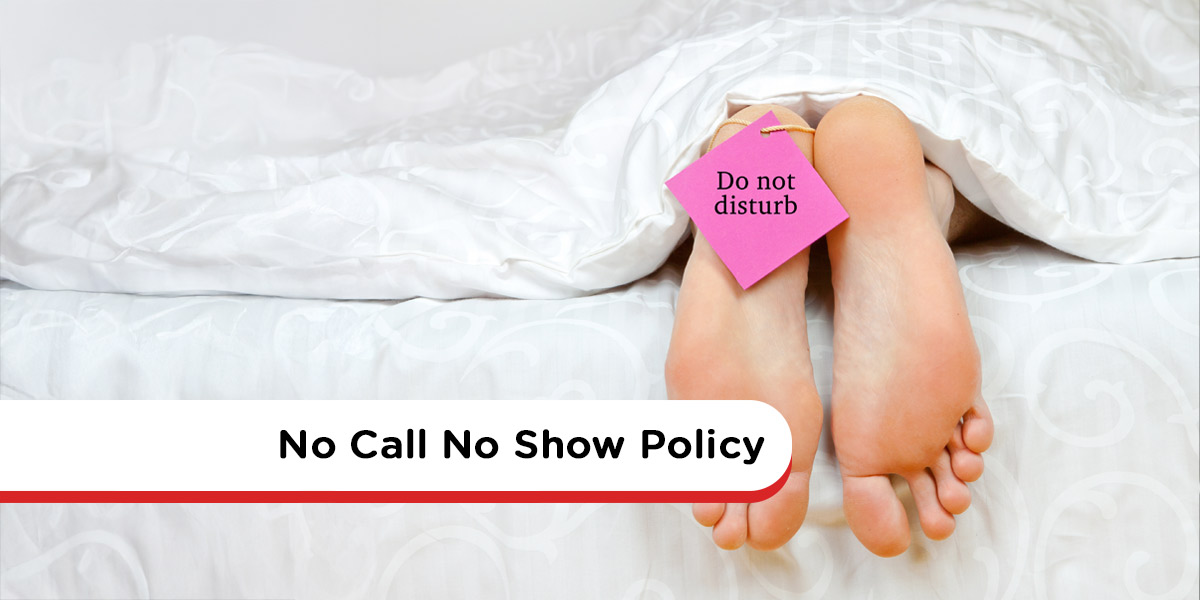Every manager knows how frustrating it is when their carefully crafted work schedule falls apart because someone fails to show up. Life happens – and that’s understandable. Whether it’s an emergency or illness, sometimes employees can’t get to work. But when your staffer doesn’t notify you, that’s a different story. You’re left in the dark and have to scramble to find cover. This situation negatively impacts productivity and puts a strain on other team members. A well-defined no-call no no-show policy can help prevent these problems. It sets your expectations and the consequences of a no-show, while outlining processes for handling missing-in-action situations.
This post pulls together all the essential information you need to create an effective no-call no no-show procedure. Include it as part of your overall attendance policy to keep your business running smoothly and efficiently.
What Is A No Call No Show?
Employees who don’t turn up for their shift and fail to notify you are considered a no-call, no-show.
Sometimes unforeseen circumstances occur, and staff are unable to report for work. It could be due to a medical emergency, transport cancellation, bereavement, or domestic crisis. Usually, employees will contact you as soon as possible to provide a heads-up, allowing you to plan accordingly.
However, missing-in-action employees are a different matter. You have no idea what’s happening or what arrangements to make. Understandably, other team members feel angry and frustrated at being left without explanation. Productivity and customer service often suffer. Additionally, you may be concerned about the welfare of the absent staff member.
Why Do I Need A No Call No Show Policy?
Without a clear policy, workers may assume it’s acceptable to disappear without notice. According to research, unscheduled absences cause an average 36.6% drop in workplace productivity. The impact goes beyond just headaches, it significantly affects your bottom line.
While a no-call no-show policy won’t eliminate all absences, it clearly communicates consequences to employees and provides managers with defined steps to manage the situation. This reduces the stress involved in handling unexplained absences and helps supervisors maintain smooth operations.
Even small businesses with only a handful of employees should implement a no-call, no-show policy. Clear expectations and guidelines make things easier for everyone, both employers and employees alike.
Develop A No Call No Show Policy In Four Easy Steps
1. Set The Rules
Guidelines may vary by business, decide what’s best for your company. For example, you might require employees to notify their manager at least 30 minutes before their shift if they can’t make it.
Determine acceptable communication methods for employees, such as a phone call or text message, directly to their supervisor. Identify unacceptable notifications, for instance, emails or business instant messaging outside standard hours when managers may not be logged in, are often ineffective. Likewise, contacting co-workers instead of managers should be discouraged.
Next, define the steps managers should take when faced with an unexplained absence. First and foremost, check on the employee’s welfare. Supervisors should attempt to call the employee to understand the situation, whether it’s a missed alarm or a serious accident.
If there’s no response after two or three attempts, the manager may contact the employee’s emergency contacts to verify their well-being. Family members can provide critical information in case of emergencies.
Once the situation is clear, managers can offer support or apply appropriate disciplinary actions if necessary, and arrange for other employees to cover the shift.
2. Identify The Consequences
Clearly communicate the consequences of unexplained absences. Fairness and reasonableness are key. Unexpected events like car accidents or family deaths understandably affect an employee’s ability to notify work.
Most companies don’t severely reprimand for a one-time no-call no-show. However, repeated offenses or multiple days without contact typically warrant disciplinary action, such as verbal or written warnings, suspension, or termination.
Many businesses adopt a “three strikes” rule: three consecutive days of unexcused absences or three separate no-call no-show incidents lead to formal disciplinary measures.
3. Have An Employment Lawyer Check Your Policy
Once you have a draft policy, it’s wise to have an employment lawyer review it. Employment laws differ by state and region. A legal expert will ensure your policy complies with all relevant regulations.
Some employees may have protected sick leave and are not obligated to disclose specific details of their absence. Laws such as the Americans with Disabilities Act (ADA) and the Family Medical Leave Act (FMLA) allow for protected leave. An employment lawyer can confirm your policy does not unlawfully penalize these workers.
4. Tell Your People About The Policy
After finalizing your no-call no no-show policy, communicate it clearly to all employees. Sending an email or updating the employee handbook isn’t enough.
Hold discussions with your staff and encourage questions to ensure full understanding. Clarify the difference between excused and unexcused absences. As a best practice, obtain written confirmation that employees have read and understood the policy to avoid misunderstandings during enforcement.
Integrate the policy into your employee onboarding program and keep it accessible on your company intranet.
Consistency is crucial. Apply the policy fairly to all employees, regardless of their status or performance, to avoid accusations of bias or discrimination.
Best Practice Tips For Reducing No Call No Shows
A no-call, no-show policy alone won’t fully solve the problem of unplanned absences. Here are some effective strategies you can implement to significantly reduce missing-in-action incidents and keep your workforce reliable.
- Ensure workers are kept updated on their shifts: One of the most common causes of a no-show is that employees are unaware of their scheduled shifts. This could be due to last-minute changes or miscommunications. Make sure to communicate work schedules regularly using reliable channels. The company intranet is an ideal platform for updates, or use push notifications through team chat tools for instant alerts.
- Get staff to accept their shifts: To reduce scheduling confusion, require employees to actively confirm their shifts. Whether through an email reply or specialized tracking software, employee confirmation eliminates excuses like “I didn’t know I was working today,” improving accountability.
- Set up an on-call list: An on-call list provides quick coverage for last-minute absences. Employees interested in extra shifts can volunteer to fill in gaps. Keep participation voluntary, as not everyone can be available at short notice, but having this backup plan reduces the operational stress caused by unexpected no-call no-shows.
Quick Summary
A no-call no-show policy is an essential tool for businesses of all sizes. Even small companies with only a few employees benefit greatly from clear, robust attendance rules.
You can develop an effective policy in four simple steps:
- Set clear rules and communication expectations
- Define consequences for unexcused absences
- Obtain legal advice to ensure compliance
- Communicate the policy clearly and enforce it consistently
Sudden, unexcused absences disrupt productivity, team morale, and customer service. A well-crafted policy helps keep your business running smoothly and your workforce engaged.
FAQs
Here are answers to some of the most common questions about no-call no-shows and how to manage them effectively.
How Many No Call No Shows Before Termination?
While terminating an employee after a single missed shift might be legally permissible, it can negatively impact your employer brand and team morale. Most companies find that a three-strikes policy strikes a good balance between fairness and ensuring consistent attendance.
How Many No-Call No-Shows Does It Take To Get Fired?
Some organizations enforce zero tolerance for unexcused absences, while others are more lenient with first-time offenders, often issuing verbal warnings. There are no universal rules , it’s important that your no-call no-show policy clearly defines the consequences. Typically, repeated unexplained absences of three days or more, or habitual offenders, face termination.
What Happens If I Do A No-Call, No-Show?
You can expect disciplinary action ranging from a verbal or written warning to suspension or even dismissal. Your company’s attendance policy will specify what actions are taken and when. You may be required to provide acceptable proof of emergency, such as a doctor’s note or police report.
Will One No Call, No Show Get You Fired?
It depends. Some employers have a strict policy and may terminate after one unexplained absence. Most apply a staged disciplinary approach with escalating consequences. However, absence exceeding three consecutive days without contact typically leads to dismissal. Always review your company’s specific attendance policy.
What Do I Do When An Employee Is A No-Call, No-Show?
If you have a no-call no no-show policy, follow the outlined steps and disciplinary procedures. If not, immediately try to contact the employee to understand the situation, whether a car breakdown, oversleeping, medical emergency, or other unforeseen event. Prioritize the employee’s welfare and provide support if needed.
Next, ensure proper coverage by redistributing the absent employee’s duties among team members or calling in off-duty staff. This helps maintain productivity and service levels despite unexpected absences.
About MyHub
We are a leading provider of cloud-hosted intranet solutions designed to connect employees with vital information, processes, and each other. With over 20 years of experience, we help organizations build beautiful, effective intranets that enhance communication and collaboration. Learn more with a free demo or 14-day no-obligation trial.



